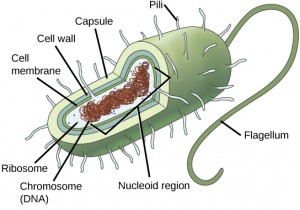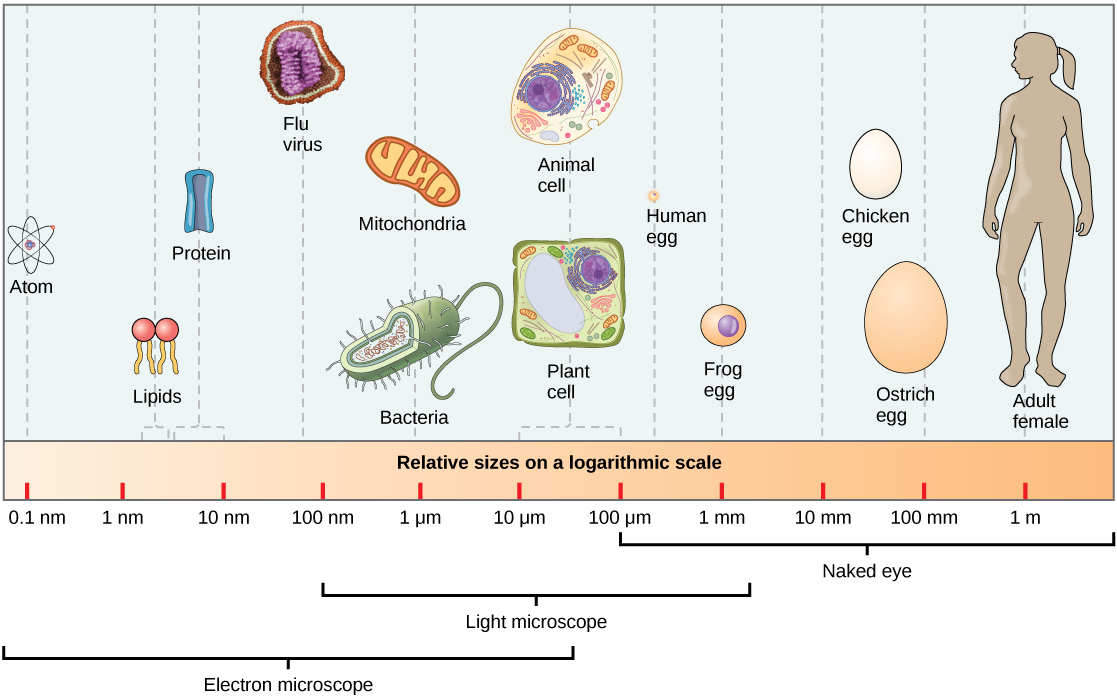How Do Prokaryotic And Eukaryotic And Animal Cells And Plant Cells Have In Common
Chapter 3: Introduction to Prison cell Structure and Role
3.2 Comparing Prokaryotic and Eukaryotic Cells
By the end of this department, you will be able to:
- Name examples of prokaryotic and eukaryotic organisms
- Compare and dissimilarity prokaryotic cells and eukaryotic cells
- Describe the relative sizes of different kinds of cells
Cells fall into one of ii broad categories: prokaryotic and eukaryotic. The predominantly single-celled organisms of the domains Leaner and Archaea are classified equally prokaryotes (pro– = before; –karyon– = nucleus). Animal cells, plant cells, fungi, and protists are eukaryotes (european union– = true).
Components of Prokaryotic Cells
All cells share four common components: i) a plasma membrane, an outer covering that separates the jail cell's interior from its surrounding environment; two) cytoplasm, consisting of a jelly-like region within the cell in which other cellular components are establish; 3) DNA, the genetic material of the cell; and four) ribosomes, particles that synthesize proteins. However, prokaryotes differ from eukaryotic cells in several ways.
A prokaryotic cell is a uncomplicated, single-celled (unicellular) organism that lacks a nucleus, or any other membrane-bound organelle. Nosotros will soon come to see that this is significantly different in eukaryotes. Prokaryotic Dna is found in the primal part of the prison cell: a darkened region called the nucleoid.

Unlike Archaea and eukaryotes, leaner have a cell wall made of peptidoglycan, comprised of sugars and amino acids, and many accept a polysaccharide capsule (Figure 3.6). The prison cell wall acts as an actress layer of protection, helps the jail cell maintain its shape, and prevents aridity. The capsule enables the cell to attach to surfaces in its environs. Some prokaryotes have flagella, pili, or fimbriae. Flagella are used for locomotion, while most pili are used to substitution genetic material during a blazon of reproduction called conjugation.
Eukaryotic Cells
In nature, the relationship between form and function is apparent at all levels, including the level of the cell, and this will get clear as nosotros explore eukaryotic cells. The principle "grade follows function" is found in many contexts. For example, birds and fish have streamlined bodies that permit them to move quickly through the medium in which they live, be it air or water. It means that, in general, one tin can deduce the role of a structure by looking at its form, because the two are matched.
A eukaryotic cell is a cell that has a membrane-bound nucleus and other membrane-bound compartments or sacs, called organelles, which have specialized functions. The word eukaryotic means "true kernel" or "true nucleus," alluding to the presence of the membrane-bound nucleus in these cells. The word "organelle" means "petty organ," and, every bit already mentioned, organelles have specialized cellular functions, just as the organs of your body have specialized functions.
Cell Size
At 0.1–5.0 µm in diameter, prokaryotic cells are significantly smaller than eukaryotic cells, which have diameters ranging from 10–100 µm (Figure three.vii). The small size of prokaryotes allows ions and organic molecules that enter them to quickly spread to other parts of the prison cell. Similarly, any wastes produced within a prokaryotic jail cell can speedily move out. However, larger eukaryotic cells have evolved different structural adaptations to heighten cellular ship. Indeed, the large size of these cells would non exist possible without these adaptations. In general, prison cell size is limited considering volume increases much more speedily than does prison cell surface surface area. As a cell becomes larger, it becomes more and more hard for the prison cell to larn sufficient materials to support the processes inside the cell, because the relative size of the surface area across which materials must exist transported declines.

Section Summary
Prokaryotes are predominantly single-celled organisms of the domains Bacteria and Archaea. All prokaryotes take plasma membranes, cytoplasm, ribosomes, a prison cell wall, DNA, and lack membrane-bound organelles. Many too have polysaccharide capsules. Prokaryotic cells range in diameter from 0.i–five.0 µm.
Like a prokaryotic cell, a eukaryotic jail cell has a plasma membrane, cytoplasm, and ribosomes, only a eukaryotic cell is typically larger than a prokaryotic cell, has a true nucleus (meaning its Dna is surrounded by a membrane), and has other membrane-bound organelles that allow for compartmentalization of functions. Eukaryotic cells tend to exist 10 to 100 times the size of prokaryotic cells.
eukaryotic cell: a cell that has a membrane-jump nucleus and several other membrane-spring compartments or sacs
organelle: a membrane-bound compartment or sac within a cell
prokaryotic cell: a unicellular organism that lacks a nucleus or any other membrane-bound organelle
Source: https://opentextbc.ca/biology/chapter/3-2-comparing-prokaryotic-and-eukaryotic-cells/
Posted by: watkinsworick.blogspot.com

0 Response to "How Do Prokaryotic And Eukaryotic And Animal Cells And Plant Cells Have In Common"
Post a Comment